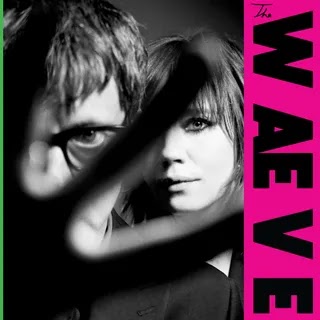Combining modular synth, saxophone, and a medieval lute, Graham Coxon and Rose Elinor Dougall create an album of pastoral disquiet and itchy post-punk edge.
Centuries of obscure folk tradition and a mistrust of isolated rural communities have helped birth a rich vein of pastoral horror in British music and film, from Incredible String Band and The Wicker Man in the late ’60s and early ’70s to Broadcast and the Focus Group in the 2000s. On their eponymous debut, the WAEVE—aka Blur guitarist Graham Coxon and former Pipettes member Rose Elinor Dougall—become the latest act to dip into this disenchanted stream. Far from the urbane chatter of Blur’s greatest hits, The WAEVE reflects the turbulence beneath the soil of Great Britain: an album of pastoral disquiet and itchy post-punk edge.
It’s not the record you might imagine from the pen of a Britpop guitar hero and a onetime ’50s girl-group revivalist. For a start, the WAEVE don’t use much guitar, leaning heavily on saxophone, piano, drums, and synth. Coxon even breaks out the cittern (a medieval lute) on “All Along,” where it bumps up against Dougall’s piano and an ARP 2000 modular synth in what might be the catchiest piece of lute work since “Greensleeves.” When the guitar does arrive, as in the warped blues solo on “Over and Over,” it is used sparingly, to shift compositional gears rather than as the sine qua non of rock melody. The lyrics, too, lean on images of nature and antiquity: the “jagged shore” and “ancient tides” on “Undine,” or “silver moon” and “ecstatic, magic night” on “Kill Me Again.”
Broadcast purists might be annoyed by how much the WAEVE borrow from the much-lamented Birmingham experimentalists, down to Dougall’s delivery of the word “surrender” on “Undine,” which comes straight from the Trish Keenan school of detached seduction. But Dougall has the songwriting talent to pull it off: Her 2017 solo album Stellular joined lovelorn synth-pop with Broadcast-esque dreaminess to enchanting effect. Add the saxophone and Coxon’s naively charming vocals, which share the limelight with Dougall’s Keenan-ian tone, and the WAEVE become a far more intriguing beast: a band with its own distinct musical palette.
The saxophone in particular is key. In rock music the sax is often used to mark an almost orgiastic explosion in emotion—à la Don Weller’s fabulously overblown saxophone solo in David Bowie’s “Absolute Beginners”—or played deliberately against type, as a signifier of sleazy grit, as in New York no wave. Coxon wields the instrument as a weapon of dissonance and unease. “Can I Call You,” the album’s excellent opening track, breaks down into a series of droning chords, while a rogue sax calls from the wilderness on “Drowning” like a woodland animal in distress.
In any case, the WAEVE have another trick up their sleeve. The strongest songs on the album come when the band kicks up into a kind of psychedelic post-punk clatter, like Wire in the state of nervy calm before the mushroom tea properly kicks in. “Kill Me Again” combines the post-Pavement lurch of Blur’s “Coffee & TV” or Coxon’s “Freakin’ Out” with a brooding synth pulse and the saxophone’s unhinged melodic commentary; “Someone Up There” is an unlikely cross between Elastica’s sharp melodic wit and Flight of the Conchords’ comic masterpiece of sentient AI revenge, “Robots.”
In his music with the WAEVE, Coxon told Guitar World, he “didn’t want to be Graham Coxon from Blur.” He largely achieves this goal on an album where guitar bends a knee to saxophone and the country is a place of esoteric ritual rather than very big houses. Those looking for Graham from Blur will find it in his laconic vocal turns and occasional guitar explosions, while Dougall’s dreamily dejected melodies will resonate with fans of her solo work. But The WAEVE has its own chemistry, an alchemic mixture of psych, punk, folk, tenderness, and dread, laced with dextrous saxophone tones and a few come-hither drops of terror.



0 comments:
Post a Comment